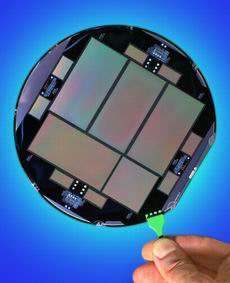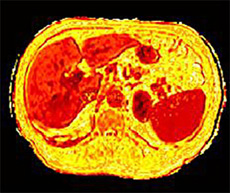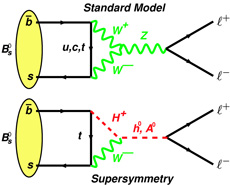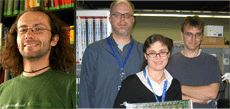|
Thurs., March 22
1:00 p.m.
ALCPG ILC Physics and Detector Seminar - Hornets' Nest (WH-8XO)
Speaker: T. Raubenheimer, Stanford Linear Accelerator Center
Title: Current ILC Machine Design and EDR Planning
1:00 p.m.
Particle Astrophysics Seminar - 1 West (NOTE DATE, TIME, LOCATION)
Speaker: R. Trotta, University of Oxford
Title: Constraining Dark Energy - Observational Status and Prospects
2:30 p.m.
Theoretical Physics Seminar - Curia II
Speaker: K. Zurek, University of Wisconsin
Title: Constraining Neutrino Properties with the Cosmic Microwave Background
3:30 p.m.
DIRECTOR'S COFFEE BREAK - 2nd Flr X-Over
THERE WILL BE NO ACCELERATOR PHYSICS AND TECHNOLOGY
SEMINAR TODAY
Fri., March 23
3:30 p.m.
DIRECTOR'S COFFEE BREAK - 2nd Flr X-Over
4:00 p.m.
Joint Experimental-Theoretical Physics Seminar - 1 West WH-8XO
Speaker: M. Goncharov, Texas A&M University
Title: Searches for Heavy Long-Lived Particles at CDF
Click here for NALCAL,
a weekly calendar with links to additional information. |
Thursday, March 22
-Southwestern chicken tortilla
-Philly style cheese steak
-Garlic herb roasted pork
-Tomato basil chicken parmesan
-Southwestern turkey wrap
-Assorted slice pizza
-Marinated grilled chicken ceasar salad
Wilson Hall Cafe Menu |
|
Thursday, March 22
Dinner
-Vichyssoise
-Monkfish w/cognac Sauce
-Herbed rice pilaf
-Steamed asparagus
-Apple galettes
Wednesday, March 28
Lunch
-Stuffed fillet of sole
-Green rice
-Steamed asparagus
-Apple raisin turnovers
Chez Leon Menu
Call x4598 to make your reservation. |
|
|
SiDet team takes care with super sensitive photo cells

A CCD wafer at Lawrence Berkeley National Laboratory. Once this wafer is diced, it will ship to Fermilab to be assembled and tested.
Engineers working in the SiDet cleanroom have recently shed their shoe covers and removed their hairnets. They've traded regular shoes for special electrostatically safe ones, and have gone over every nook and cranny in the cleanroom work area to find and remove static-prone objects. Even the tiny manufacturer's label on the tip of a torque wrench was removed because it could hold charge and generate a tiny shock.
SiDet is making all these efforts because static electricity is bad for the charge-coupled devices that the SiDet team is currently making. The problem with CCDs -- credit card-sized image sensors -- is that a very tiny amount of static electricity can ruin them. The issue has been a huge one recently, because SiDet is working on new CCD modules that go through extra steps during the assembly process. Each time a CCD is handled, it has another chance to get a shock. Worse yet, the new modules must be sensitive enough to detect photons that are 3-4 billion light years away. Such sensitive CCDs are even more vulnerable to shocks. Just 50 volts can ruin one. "When you walk on a carpet and touch a metal doorknob, the zap you feel results from thousands of volts," said engineer Greg Derylo, who has been leading the effort. "So when a CCD gets ruined, you really have no idea that it happened at all. You go through the full assembly process, and only at the end, during the electronic testing, can you tell if things are working or not."
The new modules, which could be used in the proposed Dark Energy Survey or in other future astrophysics projects, initially had a zero percent success rate. Now, with improvements made by Derylo and his colleagues Michelle Jonas, Jim Wish and Tom Diehl, CCD success has jumped to 85 percent. "It was really just a matter of looking at the risks at each step," said Derylo, "and removing or grounding anything that could hold a charge."
--Siri Steiner
|
Grids aid battle against cancer

A digital image such as this one, showing lesions in a patient's liver, can now be distributed among participating hospitals through a grid. Image courtesy of Ignacio Blanquer
Spanish medical staff in the region of Valencia have a new weapon in the arsenal against cancer. In January, a team of medical and computing researchers launched a grid-enabled infrastructure that shares oncological studies, digital images and reports among five hospitals in the Valencia region.
"In the field of oncology, quantification is very important for diagnosis," says Ignacio Blanquer, associate professor of computer science and researcher in the High Performance Computing and Networking Group, at Universidad Politécnica de Valencia in Spain. "The more information the radiologist has at hand, the more objective and accurate the diagnosis."
Read More
|
The Naperville Sun
March 20, 2007:
Swiss bliss
Woman takes work to Switzerland at world's most powerful accelerator lab - and she's only 22
Laura Jane Elgass is motivated.
She's already given speeches at Argonne National Laboratory and Duke University. Now she's headed to what will be the world's most powerful accelerator lab in Switzerland - and she's only 22.
Elgass is a sophomore bio-engineering student at the College of DuPage and part-time researcher at Fermilab. This summer she will accompany her boss, Dr. Pushpa Bhat, a Fermilab senior scientist, on a trip to the Organisation Européenne pour la Recherche Nucléaire, or CERN, in Switzerland. CERN will be home to the most powerful particle accelerator in the world when it begins operations later this year.
Read More |
|
|
Redefining high efficiency

Particle-level Feynman diagrams showing the two annihilation processes for B_s mesons. The top shows the Standard Model process, and the bottom shows possible annihilation via supersymmetric Higgs boson exchange.
The fuel that runs the engine of high-energy physics is measured in luminosity, rather than gallons. Just as with automobiles, fuel efficiency may vary greatly among users. Unlike auto fuel, however, the data recorded by Tevatron experiments is recycled: it is scrutinized by many different analyses and quality-control studies. Thus, the true measure of efficiency for an experiment's luminosity is the speed of analysis and the diversity and quality of the results produced. Members of the DZero collaboration have carefully tuned their engine and set out to overhaul the definition of high efficiency.
This month, DZero scientists reported the newest result in their search for the annihilation of a neutral B_s meson into a pair of muons using 2 inverse femtobarns of data. The Bs is a member of the B-meson family of particles, containing one bottom antiquark and one strange quark. For the B_s meson to annihilate, its constituent quarks must collide and disintegrate into a complicated mixture of W and Z bosons, the force carriers of weak interactions. This complex interaction is expected to occur in fewer than one in 300 million B_s decays. Finding one would be like finding a lost earring on a beach by examining every grain of sand! In over 100 million events, DZero researchers observed no decays of B_s mesons into two muons. This is the first 2-inverse-femtobarn result from the Tevatron, and has produced the world-best limit on the fraction of B_s decays into two muons at less than 7.5x10(-8) at 90% confidence level, the lowest limit ever set for a B_s meson decay.
But there's more mileage left in this analysis. The B_s annihilation process could also occur via a mixture of supersymmetric charged and neutral Higgs bosons. This process may occur at rates far surpassing the expected Standard Model rate, making this analysis an important indirect search channel for Higgs bosons. This indirect search complements several other direct searches currently underway at the Tevatron, and maximizes Fermilab's chances of discovering the elusive Higgs. With record luminosity poured into their tanks each day by the Tevatron, DZero researchers are revving their engines in the race for the Higgs.

Left: Ralf Bernhard (Freiburg) and Peter Tamburello (Arizona, not shown) have worked on the analysis of B_s -> mu+ mu- in the DZero data. Right: Stefan Anderson, Susan Burke, and Jeff Temple (University of Arizona, Tucson) are the experts who maintain the Level 1 Muon trigger system for DZero. Their careful work is crucial for all analyses that rely upon muons.
|
|
Spring break child care program
Exciting Explorations! is a child care program for children ages 5 through 12. Depending on interest, the program would be offered March 26-30, 2007. Please send a sack lunch. Two snacks and beverages will be provided. The cost is $35.00 per day, and payment is due when you drop off your child. A 24-hour cancellation notice is required once your child is registered.
If you would like to use the program for any of these days, please call The Children's Center at x3762 and talk to Susan, Mary or Patti. You can also email daycare@fnal.gov. Requests must be made by 12:00 p.m., March 23.
Workshop: Finding the right investment strategy
Rodney T. Weems from Fidelity Investments will hold a workshop titled, "Finding the Right Investment Strategy" on Monday, March 26. The materials presented provide an overview of the investment options offered by Fidelity. The workshop will be offered at 10:00 a.m. and 1:30 p.m. in Wilson Hall 1 West. To reserve your space, please call 1-800-642-7131.
Since the meeting is during working hours and will last for an hour, you will need your supervisor's approval to attend.
If you have any questions, please call Wilma Cardona at x6800.
Upcoming Activities
|
|